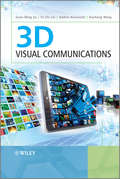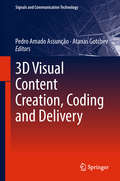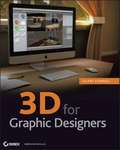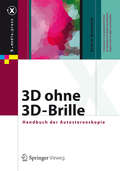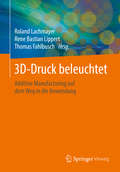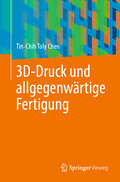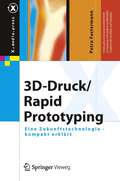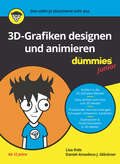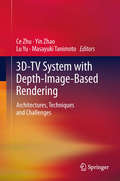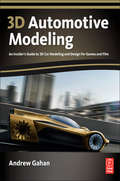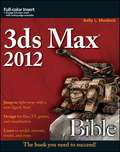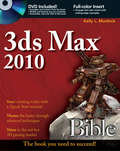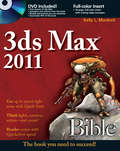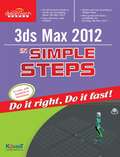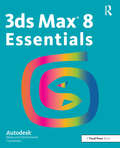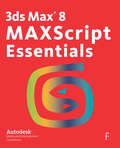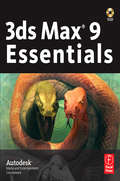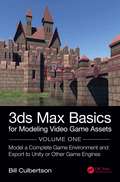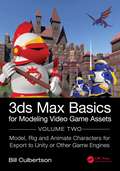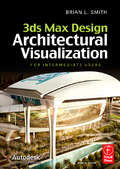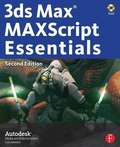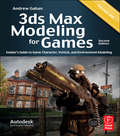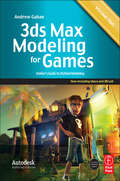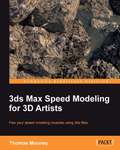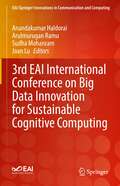- Table View
- List View
3D Visual Communications
by Yu-Chi Lai Haohong Wang Guan-Ming Su Andres KwasinskiProvides coverage of the major theories and technologies involved in the lifecycle of 3D video content deliveryPresenting the technologies used in end-to-end 3D video communication systems, this reference covers 3D graphics and video coding, content creation and display, and communications and networking. It covers the full range of key areas from the fundamentals of 3D visual representation to the latest 3D video coding techniques, relevant communication infrastructure and networks to the 3D quality of experience.The book is structured to logically lead readers through the topic, starting with generic and fundamental information, continuing with a detailed section of different visualisation techniques before concluding with an extensive view of 3D mobile communication systems and trends. The authors give most focus to four important areas: 3D video coding and communications; 3D graphics/gaming and mobile communications; end-to-end 3D ecosystem (including 3D display, 3D player, networking facility and 3D quality issues), and future communications and networks advances for emerging 3D experience.Presents the theory and key concepts behind the latest 3D visual coding framework, standards, and corresponding quality assessmentProvides fundamental material which forms the basis for future research on enhancing the performance of 3D visual communications over current and future wireless networksCovers important topics including: 3D video coding and communications; 3D graphics/gaming and mobile communications; end-to-end 3D ecosystem; and future communications and networks advances for emerging 3D experienceEssential reading for engineers involved in the research, design and development of 3D visual coding and 3D visual transmission systems and technologies, as well as academic and industrial researchers.
3D Visual Content Creation, Coding and Delivery (Signals and Communication Technology)
by Pedro Amado Assunção Atanas GotchevThis book covers the different aspects of modern 3D multimedia technologies by addressing several elements of 3D visual communications systems, using diverse content formats, such as stereo video, video-plus-depth and multiview, and coding schemes for delivery over networks. It also presents the latest advances and research results in regards to objective and subjective quality evaluation of 3D visual content, extending the human factors affecting the perception of quality to emotional states. The contributors describe technological developments in 3D visual communications, with particular emphasis on state-of-the-art advances in acquisition of 3D visual scenes and emerging 3D visual representation formats, such as: multi-view plus depth and light field;evolution to freeview and light-field representation;compression methods and robust delivery systems; andcoding and delivery over various channels. Simulation tools, testbeds and datasets that are useful for advanced research and experimental studies in the field of 3D multimedia delivery services and applications are covered. The international group of contributors also explore the research problems and challenges in the field of immersive visual communications, in order to identify research directions with substantial economic and social impact. 3D Visual Content Creation, Coding and Delivery provides valuable information to engineers and computer scientists developing novel products and services with emerging 3D multimedia technologies, by discussing the advantages and current limitations that need to be addressed in order to develop their products further. It will also be of interest to students and researchers in the field of multimedia services and applications, who are particularly interested in advances bringing significant potential impact on future technological developments.
3D for Graphic Designers
by Ellery ConnellHelping graphic designers expand their 2D skills into the 3D spaceThe trend in graphic design is towards 3D, with the demand for motion graphics, animation, photorealism, and interactivity rapidly increasing. And with the meteoric rise of iPads, smartphones, and other interactive devices, the design landscape is changing faster than ever.2D digital artists who need a quick and efficient way to join this brave new world will want 3D for Graphic Designers.Readers get hands-on basic training in working in the 3D space, including product design, industrial design and visualization, modeling, animation, lighting, and rendering?all the skills necessary in today's competitive environment.Helps 2D graphic designers gain the skills they need for a competitive job market that increasingly demands the ability to create or work in 3DCovers product design, industrial design and visualization, modeling, animation, lighting, and renderingPrepares you to create designs for iPads and other interactive mobile devices, as well as for print, Web, broadcast, film, HD, video, and moreUses Luxology modo to illustrate 3D concepts, but the author?s techniques and insights will help any artist moving into 3D, no matter what software they use This timely book is just what you need to create compelling and realistic 3D imagery and improve your job skills.
3D ohne 3D-Brille: Handbuch der Autostereoskopie (X.media.press)
by Armin GrasnickSeit dem kommerziellen Erfolg des 3D-Blockbusters ,,Avatar" im Jahr 2009 kommen immer mehr 3D-Filme und 3D-Fernseher auf den Markt. Mittlerweile gibt es Autostereoskopie-Verfahren, bei denen Zuschauer keine 3D-Brille mehr benötigen. In dem Band werden die derzeit verfügbaren Technologien der Autostereoskopie, ihre Funktionsweise, Anwendung und Limitierung allgemeinverständlich beschrieben. Zu jeder Technologie liefert der Band Anleitungen und Beispiele für die Erstellung von 3D-Inhalten. Alle Tools sind auf der begleitenden Internetseite verfügbar.
3D-Druck beleuchtet: Additive Manufacturing auf dem Weg in die Anwendung
by Roland Lachmayer Rene Bastian Lippert Thomas FahlbuschDas vorliegende Buch zeigt einen Überblick über das breite Anwendungsfeld des Additive Manufacturing, mit dem Fokus auf den industriellen Einsatz unterschiedlicher Technologien. Nach der Beschreibung eines allgemeinen Grundverständnisses und der Einschätzung zur Nutzung von Additive Manufacturing Verfahren in der Produktentwicklung werden verschiedene Technologien hinsichtlich von Nachhaltigkeits-, Individualisierungs-, Qualifizierungs- und Gestaltungsaspekten analysiert. Dabei liegt der Fokus stets auf der Betrachtung der gesamten Prozesskette, vom Pre-Prozess über den In- und Post-Prozess bis hin zur Anwendung. Die abschließende Betrachtung von Sicherheitsmerkmalen des Additive Manufacturing resultiert in der Einschätzung zukünftiger Entwicklungen im Bereich des Additive Manufacturing.
3D-Druck und allgegenwärtige Fertigung
by Tin-Chih Toly ChenDieses Buch bietet einen umfassenden Überblick über die Anwendungen von 3D-Drucktechnologien in der allgegenwärtigen Fertigung (Ubiquitous Manufacturing, UM). UM selbst stellt eine Anwendung des Ubiquitären Computings im Fertigungssektor dar, und dieses Buch zeigt, wie es bequemen, bedarfsgerechten Netzwerkzugang zu einem gemeinsamen Pool konfigurierbarer Fertigungsressourcen, einschließlich Software-Tools, Ausrüstung und Fähigkeiten, bietet. Aufgrund seines Umfangs wird das Buch für Forscher in den Bereichen Fertigung, Maschinenbau, Betriebsmanagement, Produktionssteuerung, Ubiquitäres Computing und Sensortechnologien sowie für praktizierende Manager und Ingenieure von großem Interesse sein.
3D-Druck/Rapid Prototyping: Eine Zukunftstechnologie - kompakt erklärt (X.media.press)
by Petra FastermannImmer mehr Kreative nutzen die Möglichkeit, eigene dreidimensionale Objekte in Kunststoff, Metall oder Keramik schnell und preisgünstig herstellen zu lassen. Der 3D-Druck ist eine revolutionäre Technologie, die dieVerwirklichung von Ideen ermöglicht. 3D-Drucker werden immer kleiner und leistungsstärker und damit bürotauglicher. Eine umfassende Beschreibung dieser Zukunftstechnologie bietet dieses praxisnahe und anwenderorientierte Buch. Dabei hilft es mit Tipps und Hinweisen bei der Auswahl des optimalen CAD-Programms und 3D-Druckers.
3D-Grafiken Designen und animieren für Dummies Junior (Für Dummies)
by Daniel-Amadeus J. Glockner Lisa IhdeIn diesem Buch lernst du Schritt für Schritt, wie du mit der kostenlosen Software Blender 3D-Objekte für Computerspiele, Videos oder für die Produktion im 3D-Drucker erstellst. Du erfährst, wie du aus einem 2D-Bild ein 3D-Modell machst, wie du das Material änderst, aus dem dein Objekt scheinbar hergestellt ist, wie du Oberflächen gestaltest und was es mit der Mesh-Modellierung auf sich hat. Außerdem kannst du deine Objekte animieren oder beispielsweise Explosionen simulieren. Bestens geeignet für Kinder und Jugendliche ab 12 Jahren.
3D-TV System with Depth-Image-Based Rendering: Architectures, Techniques and Challenges
by Masayuki Tanimoto Ce Zhu Lu Yu Yin ZhaoRiding on the success of 3D cinema blockbusters and advances in stereoscopic display technology, 3D video applications have gathered momentum in recent years. 3D-TV System with Depth-Image-Based Rendering: Architectures, Techniques and Challenges surveys depth-image-based 3D-TV systems, which are expected to be put into applications in the near future. Depth-image-based rendering (DIBR) significantly enhances the 3D visual experience compared to stereoscopic systems currently in use. DIBR techniques make it possible to generate additional viewpoints using 3D warping techniques to adjust the perceived depth of stereoscopic videos and provide for auto-stereoscopic displays that do not require glasses for viewing the 3D image. The material includes a technical review and literature survey of components and complete systems, solutions for technical issues, and implementation of prototypes. The book is organized into four sections: System Overview, Content Generation, Data Compression and Transmission, and 3D Visualization and Quality Assessment. This book will benefit researchers, developers, engineers, and innovators, as well as advanced undergraduate and graduate students working in relevant areas.
3d Automotive Modeling: An Insider's Guide to 3d Car Modeling and Design for Games and Film
by Andrew GahanMaster techniques from top automotive designers and world-class game developers with this insider's guide to designing and modeling 3D vehicles. With techniques demonstrated in 3ds Max, Maya, XSI, and Photoshop, "3D Automotive Modeling" starts with a fantastic series of hot concept designs and continues by offering a full hands-on modeling tutorial for each. Some of the very best designers and modelers from across the globe take you through their processes step-by-step, giving you the tips, tricks, and short-cuts that true professionals use. "3D Automotive Modeling" features tutorials from Honda, Toyota, and Mercedes-Benz designers, as well as modelers from Sony Computer Entertainment, Lucas Arts, and Simbin-artists who have worked on some of the biggest games in the industry, including the MotorStorm series. You will get: insider tips from a team of noted professionals, led by author Andrew Gahan, part of the award-winning game team behind the PlayStation 3 smash hit series, MotorStorm; all tutorial files, models, textures, blueprints, and concept images on the associated web site; and, access to a vibrant forum on the web site where you can discuss and share your work and get feedback from the pros.
3ds Max 2010 Bible
by Kelly L. MurdockThe bestselling 3ds Max book ever, now updated for the latest version3ds Max is the world's most popular animation modeling and rendering software used to create 80 percent of commercially available video games, including those for Microsoft's Xbox 360, Sony's Playstation 3, and Nintendo's Wii. It is an expensive, intricate program that can take years to thoroughly master.As the ultimate comprehensive reference and tutorial on 3ds Max, this guide contains in-depth coverage of every aspect of 3ds Max and explores the newest features that the latest version has to offer. You'll learn to master the complexities of 3ds Max under the guidance of 3D expert Kelly Murdock.Includes in-depth detail on all the latest features for veterans of earlier versions of 3ds Max from 3D expert Kelly MurdockShares expert advice, timesaving techniques, and more than 150 step-by-step tutorialsFeatures a 16-page, full-color insert with inspiring examples of cutting-edge 3ds Max artBonus DVD contains all the examples from the book, unique models and textures that you can customize on your own, and a searchable, full-color version of the bookA Quick Start chapter shows you how to create an exciting animation on your very first day with the software so you can dive in and get started immediately.Note: CD-ROM/DVD and other supplementary materials are not included as part of eBook file.
3ds Max 2010 Bible (Bible #590)
by Kelly L. MurdockThe bestselling 3ds Max book ever, now updated for the latest version 3ds Max is the world's most popular animation modeling and rendering software used to create 80 percent of commercially available video games, including those for Microsoft's Xbox 360, Sony's Playstation 3, and Nintendo's Wii. It is an expensive, intricate program that can take years to thoroughly master. As the ultimate comprehensive reference and tutorial on 3ds Max, this guide contains in-depth coverage of every aspect of 3ds Max and explores the newest features that the latest version has to offer. You'll learn to master the complexities of 3ds Max under the guidance of 3D expert Kelly Murdock. Includes in-depth detail on all the latest features for veterans of earlier versions of 3ds Max from 3D expert Kelly Murdock Shares expert advice, timesaving techniques, and more than 150 step-by-step tutorials Features a 16-page, full-color insert with inspiring examples of cutting-edge 3ds Max art Bonus DVD contains all the examples from the book, unique models and textures that you can customize on your own, and a searchable, full-color version of the book A Quick Start chapter shows you how to create an exciting animation on your very first day with the software so you can dive in and get started immediately. Note: CD-ROM/DVD and other supplementary materials are not included as part of eBook file.
3ds Max 2011 Bible (Bible #719)
by Kelly L. MurdockUpdated version of the bestselling 3ds Max book on the market Used by more than 150,000 people, and the winner of more than 65 industry awards, 3ds Max is the world's most popular animation modeling and rendering software for film, television, video games, and design visualization. 3ds Max Bible is the world’s most popular book for getting the most out of the software. Whether a novice looking to create something immediately using the Quick Start tutorial, or an experienced 3ds Max user who simply wants to check out the software's latest and greatest features, this update to the bestselling 3ds Max book on the market continues to be the most comprehensive reference on this highly complex application. Packed with expert advice, timesaving tips, and more than 150 step-by-step tutorials 16-page color insert highlights the work of some of today’s most cutting-edge 3D artists Includes a companion DVD with a searchable, full-color version of the 3ds Max Bible, as well as customizable models and textures The only comprehensive reference-tutorial on 3ds Max, it's no wonder the 3ds Max Bible is the bestselling 3ds Max book in the world and a favorite of both amateur and professional animators. Note: CD-ROM/DVD and other supplementary materials are not included as part of eBook file.
3ds Max 2012 In Simple Steps
by Kogent Learning Solutions Inc3Ds Max 2012 In Simple Steps Author: Kogent Learning Solutions Inc.
3ds Max 8 Essentials: Autodesk Media and Entertainment Courseware (Autodesk Media And Entertainment Courseware Ser.)
by AutodeskWelcome to the Autodesk Media and Entertainment Official Training Courseware for 3ds Max 8 software! Consider this book an all-access pass to the production and training experience of Autodesk developers and training experts. Written for self-paced learning or instructor-led classroom training, the manual will teach you the fundamentals of using 3ds Max 8. The book is organized into sections dedicated to animation, modelling, materials, lighting and rendering. Each section covers basic theory, and then includes exercises for hands-on demonstration of the concept. By the end of the book, you will have mastered the basics and moved onto full-length projects. Flexibility is built in, so that you can complete the tutorials in the way that works best for you. Complete the book and you will be a seasoned 3ds Max pro, ready to work confidently in a production environment.
3ds Max 8 MAXScript Essentials
by AutodeskWrite your own MAXScript functions and utilities to create custom tools and UI elements, and automate repetitive tasks. Demonstrated techniques include the creation of objects, arrays, collections, control structures, parametric objects, and the construction of UI elements. The companion CD-ROM contains media files that allow you to practice the techniques with real-world examples demonstrating how you can use then in a production environment.
3ds Max 9 Essentials: Autodesk Media and Entertainment Courseware
by AutodeskBring 3D film effects to the big screen. Generate realistic characters for a top-selling game. Create rich and complex design visualization. Autodesk® 3ds Max® 9 lets you maximize your productivity and tackle challenging animation projects. And this book, developed by Autodesk insiders, lets you master the essential tools and techniques. Learn how to use 3ds Max 9 confidently in a production environment. Each chapter of this book has a series of theory lessons and one lab. The theory lessons introduce you to the functional areas of 3ds Max and explain these features with short simple examples. The lab demonstrates a practical application of the theory. Combined, each chapter delivers a sound understanding of the functions, features and principles behind 3ds Max 9, and shows you how to apply this knowledge to real-world situations.
3ds Max Basics for Modeling Video Game Assets: Model a Complete Game Environment and Export to Unity or Other Game Engines
by William CulbertsonA textbook for learning 3d modeling fundamentals, this step-by-step lesson book develops the readers modeling skills through a series of modeling exercises creating modules for a medieval castle environment. As the text introduces new modeling skills it additionally calls on the reader to perform repetitive tasks, reinforcing skills learned in the process. The content is presented as if the reader is in a working video game studio, being responsible for researching asset design, providing the team with placeholder assets, and final model assets that are unwrapped and custom textured. Upon completion of the modeling projects, the modeled environment is exported to the Unity game engine for use in a real game environment, Although the text uses Autodesk 3ds Max for the modeling program, the principals are transferable to other major modeling programs. Key Features: The goal of this book is to teach the fundamentals of 3d modeling video game assets in a simplified, logical progression, optimized for learning at a beginner level. This series of modeling exercises is the result of having taught over one thousand video game students the fundamentals of 3d modeling. Often, teachers are not fully trained in teaching the concepts of 3d modeling. This text, written for self-paced learning helps those instructors. Includes instructions and project files for exporting the finished project environment into a 3d game engine, Unity. Appendices include additional 3ds Max tool instructions. A companion site includes working 3ds Max project files for Chapters, a 3ds Max user interface and 3ds Max short cut keys and more.
3ds Max Basics for Modeling Video Game Assets: Volume 2: Model, Rig and Animate Characters for Export to Unity or Other Game Engines
by William CulbertsonAs a textbook for learning the fundamentals of modeling, rigging and animating 3D-modeled characters for use in video games, this step-by-step lesson book builds on the reader's modeling skills acquired from reading Volume I. The reader will model characters for the Castle Environment created in Volume I, which will be rigged using the Character Animation Toolkit (CAT) in 3ds Max and animated with game moves. The Skin Modifier is used for associating the meshes to the rigs and the characters are then exported to the Unity game engine and integrated into the Castle Scene with a Third Person Character camera. As the text introduces new modeling skills, it additionally calls on the reader to perform repetitive tasks, reinforcing skills learned in the process. The content is presented as if the reader is in a working video game studio, being responsible for researching asset design and providing the team with placeholder assets and final model assets that are unwrapped and custom textured using both box mapping and the 3ds Max Quick Peel tool. Although the text uses Autodesk 3ds Max for the modeling program, the principles are transferable to other major modeling programs. Key Features: The goal of this book is to teach the fundamentals of 3D modeling video game characters in a simplified, logical progression optimized for learning at a beginner level. Rigging principles (Linking, Inverse Kinematics [IK], Forward Kinematics [FK], Skin Deformation, Weighting Vertices and more) are introduced in a gradual progression to allow maximum comprehension and retention. This series of modeling exercises is the result of having successfully taught over 1000 video game students the fundamentals of 3D modeling. This complete, clearly written and concise text is written for self-paced learning, helping those instructors who might not be fully trained in 3D modeling and those interested in self-teaching. Includes instructions and project files for exporting the finished project environment into the 3D game engine, Unity. A companion site (www.3dsMaxBasics.com) includes working 3ds Max project files for chapters, notes and corrections, a 3ds Max user interface, 3ds Max shortcut keys and more.
3ds Max Design Architectural Visualization: For Intermediate Users
by Brian L. SmithLearn time-saving techniques and tested production-ready tips for maximum speed and efficiency in creating professional-level architectural visualizations in 3ds Max. Move from intermediate to an advanced level with specific and comprehensive instruction with this collaboration from nine different authors from around the world. Get their experience and skills in this full-color book, which not only teaches more advanced features, but also demonstrates the practical applications of those features to get readers ready for a real production environment. Fully updated for the most recent version of 3ds Max.
3ds Max MAXScript Essentials
by AutodeskWrite your own MAXScript functions and utilities to automate repetitive tasks and create custom tools and UI elements. Beginning with an introduction to essential programming concepts, you learn the MAXScript basics that include cloning objects, MAX commands, toolbar access, picking scene nodes, picking points, and using the mousetrack command and painter interface. Real-world tutorial examples are provided throughout the book to demonstrate how to use the MAXScript techniques in your own production environment.
3ds Max Modeling for Games: Insider's Guide to Game Character, Vehicle, and Environment Modeling
by Andrew GahanWith 18 years under his belt in the game industry, a key contributor to the MotorStorm series, and the creator of the 3ds Max in Minutes video series (at FocalPress.com), Andrew Gahan delivers the expert techniques in 3ds Max Modeling for Games, 2nd edition. This updated edition is packed with new tutorials that will enhance your modeling skills and pump up your portfolio with high-quality work in no time. Along with Anthony O'Donnell and a team of experts, Gahan covers all of the fundamental game modeling techniques, including character and environment modeling, mapping, and texturing. Finally, a bonus section in 3ds Max Modeling for Games offers readers insights and tips on how to get their careers started in the game industry. New, expanded tutorials take readers of all abilities through full character and environment modeling from beginning to end Companion website (3d-for-games.com) offers a robust, supportive forum where readers can get commentary on new work, develop skills and portfolio art, as well as network with other game artists on a variety of projects. Also features project files for all tutorials in the book and enough support images and photos to keep the budding artist busy for months Completely updated gallery allows the reader to build on various models
3ds Max Modeling for Games: Insider's Guide to Stylized Game Character, Vehicle and Environment Modeling
by Andrew GahanThere's a new trend towards sylized, comic-style art, with the latest wave of 3D movies (a la Pixar ). Max users can do this kind of thing, and they want to learn how. Andy Gahan is building on the success of his Focal book, 3ds Max Modeling for Games (which covers realistic style art) with this new VOLUME II, covering stylized comic-style art. Forum members are asking for this treatment, and we are delivering. We are linking up to original book branding and titling, and offering the same robust portal for both books - the art on the cover will show the distinction of this volume. The book will offer new modeling techniques, specifically cartoon style - think Pixar, offering new challenges to people who bought Volume I (which focused on more realistic art). Website (www.3d-for-games.com) is unique - an online forum where readers can post and answer questions about their work. In terms of developing a portfolio, online peer critiques are invaluable, and current readers have made use of this feature, in fact some have happily become the forum responders (along with Andy) to coach and develop new artists at work. Also included: step-by-step project files for each chapter; all the relevant texture files and source photos; panoramic skies, small scene objects, bonus texture maps & models so that artists can create whole scenes very quickly without starting from scratch each time; countless examples of what's hot and what's not in 3D modeling and also enough support images and photos to keep the budding artist busy for months. Unrivalled support in over 10,000 current posts - backing up the book with a lively forum and community of readers from all over the world, ready to help your work.
3ds Max Speed Modeling for Games
by Thomas MooneyStep by step illustrated tutorials are supported by a focused commentary. The examples are designed to proceed from starting to model through model finishing to putting models to work within projects and presentation. The book shows both - the entire flow of asset creation and granular methodology. This book will appeal to anyone interested in 3D modeling who wants to improve their speed modeling ability, particularly artists whose work is relevant to industries where hard surface modeling or model prototyping is required, such as games, films, or visualization.
3rd EAI International Conference on Big Data Innovation for Sustainable Cognitive Computing (EAI/Springer Innovations in Communication and Computing)
by Anandakumar Haldorai Arulmurugan Ramu Sudha Mohanram Joan LuThis book features the proceedings of The EAI International Conference on Big Data Innovation for Sustainable Cognitive Computing (BDCC 2020), which took place 18 – 19 December 2020. The papers feature detail on cognitive computing and its self-learning systems that use data mining, pattern recognition and natural language processing (NLP) to mirror the way the human brain works. This international conference focuses on technologies from knowledge representation techniques and natural language processing algorithms to dynamic learning approaches. Topics covered include Data Science for Cognitive Analysis, Real-Time Ubiquitous Data Science, Platform for Privacy Preserving Data Science, and Internet-Based Cognitive Platform.
